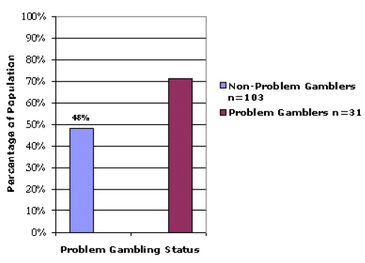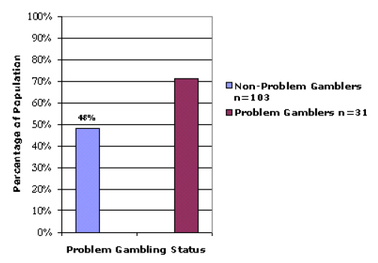Many researchers consider pathological gambling to be an impulse disorder. Based on this, we might expect other impulsive behaviors to be prominent in populations of people who have gambling problems. This week’s WAGER explores this issue by reporting on a study that investigated HIV sexual risk among substance abusing problem and non-problem gamblers (Petry, 2000).
Petry enrolled 134 individuals, recruited from newspaper advertisements and social service agencies, with lifetime histories of probable alcohol, cocaine, or heroin abuse. Substance abuse was considered to be at least a 1-year regular pattern of: (1) alcohol use to intoxication at least three times weekly; or (2) daily use of heroin; or (3) at least eight times per month use of cocaine. In addition, researchers considered loss of control and problems related to the use of one or more of these drugs to be evidence of substance abuse. Trained research assistants collected demographic information and administered the Addiction Severity Index (ASI; McLellan et al, 1998), the South Oaks Gambling Screen (SOGS; Lesieur & Blume, 1987), the Eysenck Impulsivity Questionnaire (Eysenck & Eysenck, 1978), the HIV Risk Behavior Scale1 (HRBS; Darke et al., 1991), and the HIV Risk Knowledge Test2 (Kelly et al., 1989).
Based on SOGS scores, 24% (n=31) of the 134 substance abusers (SAs) evidenced probable pathological gambling. SAs with a gambling problem were more likely to be male than SAs without a gambling problem. No other significant differences among the demographic characteristics were observed. However, there were significant differences between these two groups in their HRBS scores. For example, problem gamblers were more likely than non-problem gamblers to trade sex for drugs or money (Figure 1). Further, among those who traded sex for drugs or money, problem gamblers were less likely than non-problem gamblers to use condoms. (Figure 2).
Figure 1 – Percentage of Total Sample That Has Traded Sex For Money (N=134)
Figure 2 – Frequency of Condom Use Among Those Who Exchange Sex For Money (N=71)
The data from this study suggest that SAs with gambling problems might be at a higher risk for contracting HIV. In this study, SAs with gambling problems reported more risk behaviors and a larger proportion of these SAs traded sex for drugs or money. Further, of SAs who traded sex for favors, those with gambling problems used condoms less frequently when compared to their counterparts without gambling problems.
There are limitations to the study. As Petry notes, the findings might not be generally applicable to the larger population of SAs because the sample was small and limited to one geographic area: Hartford, CT. Also, over 90% of the study population identified as heterosexual. Given this, there is not a representative portion of other populations at high risk for HIV. If this is true, then the study’s assessment of HIV risk might be an underestimate. Finally, this study was limited to substance abusers. Thus, it is unclear how these findings will relate to non-substance abusing pathological gamblers.
The SOGS’s ability to predict risky sexual behavior raises a larger concern about psychological instruments. For example, if the SOGS is measuring pathological gambling and also predicts sexual risk, perhaps there is an additional factor common to both pathological gambling and sexual risk that is registering on the SOGS. Thus, the SOGS might have poor discriminant validity. Researchers should explore whether this predictive ability is unique to this instrument, or all measures of gambling pathology.
Alternatively, perhaps scientists should develop instruments that directly test for underlying factor(s) for sexual risk and pathological gambling. For example, some studies support the idea that addiction is a manifestation of impulsivity (e.g. Madden et al., 1997). Perhaps taking sexual risks or gambling pathologically is influenced by an impulsivity trait. In this case, the SOGS could be revealing that element of impulsivity that might underlie both pathological gambling and sexual risk behavior.
This study is valuable because it opens new areas for consideration. The study’s suggestion that pathological gamblers with substance abuse problems might be at a higher risk for contracting HIV has implications for assessment and treatment. Treatment seekers should be screened for, not only gambling behavior, but also sexual behavior, physical risk taking, etc., and conversely, substance users should be evaluated for gambling problems and other impulsive behaviors. This study broadens awareness of other potential health risks for those with gambling problems. In fact, if a common trait underlies gambling and other disorders, then gambling problems might serve as an important marker for other risk related problems. Therefore, this study encourages clinicians to screen a broad range of patients for gambling related problems as a proxy for a variety of behavioral problems. Each of these ideas requires more research before any broad conclusions are drawn.
Notes
1 This instrument measures intravenous drug use and sexual risk behaviors.
2 This instrument is true-false test of knowledge of HIV transmission
References
Crockford, D. N., el-Guebaly, N. (1998). Psychiatric comorbidity in pathological gambling: A critical review. Canadian Journal of Psychiatry, 43(1), 43-50.
Darke, S., Hall, W., Heather, N., Ward, J. & Wodak, A. (1991). The reliability and validity of a scale to measure HIV risk-taking behaviour among intravenous drug users. AIDS, 5, 181-185.
Eysenck, S.B. & Eysenck H.J. (1987). Impulsiveness and venturesomeness: their position in a dimensional system of personality description. Psychological Reports, 43, 1247-1255.
Kelly, J.A., St Lawrence, J.S., Hood, H.V. & Brasfield, T.L. (1989). An objective test of AIDS risk behavior knowledge: scale development, validation, and norms. Journal of Experimental Psychology: General, 20, 227-234.
Lesieur, H.R. & Blume, S. (1987). The South Oaks Gambling Screen (The SOGS): a new instrument for the identification of pathological gamblers. American Journal of Psychiatry, 144, 1184-1188.
Madden, G.J., Petry, N.M., Badger, G.J., Bickel, W.K. (1997) Impulsive and self-controlled choices in opioid-dependent and non-drug using controls: drug and monetary rewards, Experimental and Clinical Psychopharmacology, 5, 256-262.
McClellan, A.T., Luborsky, L., Cacciola, J. & Griffith, J. (1998).
Guide to the Addiction Severity Index: background, administration, and field testing results, US DHHS publication no. (ADM), 88-1419 (Rockville, MD, US Department of Health and Human Services, National Institute on Drug Abuse).
Petry, N. (2000). Gambling problems in substance abusers are associated with increased sexual risk behaviors. Addiction, 95(7), 1089-1100.
The WAGER is a public education project of the Division on Addictions at Harvard Medical
School. It is funded, in part, by the National Center for Responsible Gaming, the
Massachusetts Department of Public Health, the Addiction Technology Transfer Center of
New England, the Substance Abuse and Mental Health Services Administration, and the
Center for Substance Abuse Treatment.






